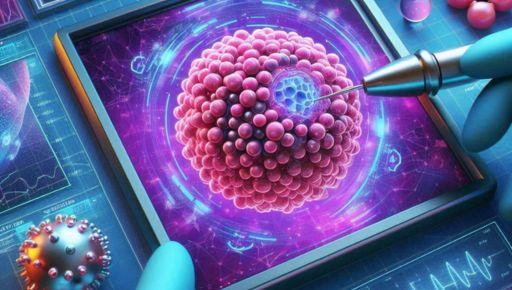Magnetic Nanoparticles: A Breakthrough in Cancer Imaging Technology

Cancer is a global health challenge, and advancements in diagnostic technologies are crucial for early detection and effective treatment. Among these innovations, magnetic nanoparticles for cancer imaging have emerged as a revolutionary tool. These tiny, engineered particles, which can be controlled using magnetic fields, offer precise, non-invasive, and highly sensitive imaging capabilities, making them invaluable in the fight against cancer.
This article explores how magnetic nanoparticles work, their role in cancer imaging, their benefits, and their future potential.
What are Magnetic Nanoparticles?
Magnetic nanoparticles (MNPs) are nanoscale materials, typically ranging from 1 to 100 nanometers, with magnetic properties. They are composed of magnetic materials such as iron oxide (Fe₃O₄), cobalt, or nickel, and are often coated with biocompatible materials to ensure safety and functionality in biological systems.
Key Properties of Magnetic Nanoparticles
- Magnetic Responsiveness:
MNPs respond to external magnetic fields, enabling controlled movement and targeting within the body. - Surface Functionalization:
Their surfaces can be modified with ligands, antibodies, or peptides for specific targeting of cancer cells. - Size and Shape:
Their nanoscale size allows them to easily circulate through the bloodstream and penetrate tissues. - Superparamagnetism:
This property ensures that the particles exhibit magnetic behavior only in the presence of an external field, reducing the risk of particle aggregation in the body.
Role of Magnetic Nanoparticles in Cancer Imaging
1. Enhanced Magnetic Resonance Imaging (MRI)
Magnetic nanoparticles are widely used as contrast agents in MRI. When injected into the body, they improve the contrast of images by altering the magnetic properties of surrounding tissues.
- How it works:
MNPs shorten the T2 relaxation time of protons in nearby water molecules, resulting in darker and more defined images in T2-weighted MRI scans. This enhanced contrast helps in identifying cancerous tissues with greater clarity. - Applications:
- Detection of tumors.
- Monitoring tumor growth and response to therapy.
2. Targeted Imaging
MNPs can be functionalized with tumor-specific targeting agents, such as antibodies or peptides, which bind to biomarkers on cancer cells. This ensures that the nanoparticles accumulate specifically in cancerous tissues, allowing precise imaging of tumors.
3. Dual-Modality Imaging
Magnetic nanoparticles can be combined with other imaging modalities, such as fluorescence or computed tomography (CT), to provide comprehensive information about tumor size, location, and metabolic activity.
Advantages of Magnetic Nanoparticles in Cancer Imaging
1. Non-Invasive Diagnostics
Magnetic nanoparticles enable accurate imaging without the need for invasive procedures, reducing patient discomfort and risk.
2. High Sensitivity and Specificity
The functionalization of MNPs ensures selective targeting of cancer cells, minimizing false positives and enhancing diagnostic accuracy.
3. Real-Time Monitoring
MNPs allow for real-time imaging of tumor progression and response to treatment, aiding in personalized cancer management.
4. Biocompatibility
Coatings such as polyethylene glycol (PEG) or silica ensure that MNPs are biocompatible, reducing toxicity and making them safe for clinical use.
5. Versatility
Magnetic nanoparticles can be used in conjunction with therapeutic agents for theranostic applications, where diagnosis and therapy are combined.
Applications of Magnetic Nanoparticles in Cancer Imaging
1. Brain Tumors
MNPs can cross the blood-brain barrier and enhance imaging of brain tumors, which are often challenging to detect with conventional methods.
2. Breast Cancer
Functionalized MNPs target HER2 receptors in breast cancer cells, improving early detection and monitoring.
3. Prostate Cancer
Targeted magnetic nanoparticles provide high-resolution imaging of prostate tumors, aiding in accurate staging and treatment planning.
4. Lymph Node Imaging
MNPs are used to map sentinel lymph nodes, helping to determine whether cancer has spread beyond the primary tumor site.
Challenges and Limitations
Despite their immense potential, the use of magnetic nanoparticles in cancer imaging is not without challenges:
1. Toxicity Concerns
- Some magnetic materials, such as cobalt or nickel, may have toxic effects.
- Long-term accumulation of nanoparticles in organs like the liver or spleen requires further investigation.
2. Regulatory Hurdles
Ensuring the safety and efficacy of MNPs for clinical use involves extensive testing, which can delay their availability in the market.
3. Cost
The synthesis and functionalization of MNPs are complex and expensive, which may limit their widespread adoption.
4. Uniformity
Achieving consistent size, shape, and functionalization of nanoparticles is crucial for reliable performance but remains a manufacturing challenge.
Future Directions and Innovations
1. Multi-Functional Nanoparticles
Future research is focusing on designing MNPs that combine imaging, drug delivery, and therapeutic capabilities. These multifunctional nanoparticles can diagnose and treat cancer simultaneously.
2. Advanced Coating Materials
Development of novel coatings to improve biocompatibility, reduce toxicity, and enhance targeting efficiency is underway.
3. Integration with Artificial Intelligence (AI)
AI algorithms can analyze data obtained from MNP-based imaging, enabling earlier detection and more precise diagnosis of cancer.
4. Clinical Trials and Approval
Ongoing clinical trials aim to establish the safety and efficacy of MNPs, paving the way for their approval and commercialization.
5. Personalized Medicine
Functionalized MNPs tailored to individual patient profiles will enable customized imaging and treatment strategies.
Conclusion
Magnetic nanoparticles are revolutionizing cancer imaging by offering enhanced sensitivity, specificity, and non-invasive diagnostic capabilities. Their ability to precisely target tumors and improve the clarity of imaging modalities like MRI positions them as a cornerstone of modern cancer diagnostics.
While challenges such as toxicity, cost, and regulatory hurdles remain, ongoing research and technological advancements promise to unlock the full potential of magnetic nanoparticles. As these innovations continue to mature, magnetic nanoparticles will play an increasingly vital role in early cancer detection, personalized treatment, and improved patient outcomes, heralding a new era in oncological care.




